Understanding the Connection Between Mindfulness and Sleep

Do you ever find yourself tossing and turning at night, struggling to fall asleep? You are not alone. Many people deal with insomnia, finding it hard to relax and drift off. One approach that has shown real promise in improving sleep quality is mindfulness. But how exactly does it help?
Mindfulness is about staying present in the moment. When you practice mindfulness, you learn to notice your thoughts and feelings without getting caught up in them. This can be incredibly helpful for sleep, especially if you often have racing thoughts or worry at bedtime. By gently bringing your focus back to the present, mindfulness can make it easier to relax and fall asleep.
The Difference Between Regular Bedtime Routines and Mindful Sleep Practices
Many of us are familiar with traditional bedtime routines, such as going to bed at the same time every night, avoiding screens, or keeping our rooms dark and cool. These routines can certainly help, but for those with chronic insomnia, they might not be enough. This is where mindfulness-based approaches come in. Unlike traditional methods that address external factors, mindfulness helps manage internal obstacles, like stress, anxiety, and racing thoughts.
Comparison: Traditional Sleep Hygiene vs. Mindful Sleep Practices
| Traditional Sleep Hygiene | Mindful Sleep Practices |
|---|---|
| Focuses on external conditions | Focuses on internal state of mind |
| Set bedtime routines | Awareness of thoughts and emotions |
| Avoid screens before bed | Breathing and relaxation exercises |
Mindfulness practices are specifically designed to help individuals address internal challenges that often prevent restful sleep, offering a new path for those who have tried traditional methods without success.
Why Insomniacs Need a Different Approach
For people with insomnia, racing thoughts and persistent anxiety can make falling asleep feel impossible. Unlike traditional advice that focuses on habits, mindfulness targets the mental and emotional struggles unique to insomniacs. Below are some of the common challenges insomniacs face:
- Racing thoughts at bedtime
- Increased anxiety when trying to sleep
- Difficulty letting go of daytime worries
- Feeling frustrated about being unable to sleep
Mindfulness helps tackle these issues by encouraging a non-judgmental awareness of thoughts and feelings, making it easier to break free from the cycle of sleeplessness and frustration.
5 Mindful Bedtime Routines for Better Sleep
Now that we understand how mindfulness can be beneficial, let’s dive into some specific bedtime routines that can help you sleep better.
1. The Body Scan Wind-Down
This practice involves slowly focusing on different parts of your body, releasing tension as you go. Here’s how to do it:
- Estimated Time: 10-15 minutes
- Steps: Lie down comfortably. Bring your focus to your toes. Notice any sensations and allow yourself to relax. Slowly move your attention up your body, part by part, until you reach your head.
- Tips for Customization: You can add deep breathing while scanning each area for extra relaxation.
- Common Challenges: If your mind wanders, gently bring your focus back to the body part you are scanning.
2. Breath-Focused Relaxation Technique
This practice centers on focusing your attention on your breath to help calm your mind. Here’s how to do it:
- Estimated Time: 5-10 minutes
- Steps: Sit or lie down in a comfortable position. Close your eyes and bring your attention to your breath. Notice the sensation of air entering and leaving your body. If your mind starts to wander, gently guide your focus back to your breathing.
- Different Breathing Patterns: Try 4-7-8 breathing (inhale for 4 seconds, hold for 7, exhale for 8) or box breathing (inhale for 4 seconds, hold for 4, exhale for 4, hold for 4).
- Handling Intrusive Thoughts: If thoughts arise, acknowledge them without judgment and bring your focus back to your breath.
- Success Indicators: You should feel a gradual sense of relaxation and a slower heart rate.
3. Mindful Journaling for Racing Thoughts
Mindful journaling can help release racing thoughts by putting them onto paper. Here’s how to do it:
- Estimated Time: 10-15 minutes
- Template for Journaling Prompts: Write down any worries or thoughts that are on your mind. Focus on how you are feeling in the moment without trying to solve anything.
- What to Write: Describe your thoughts and feelings in detail. Avoid judging yourself or your emotions.
- Sample Journal Entry: “Tonight, I am feeling anxious about work. I notice my chest feels tight, and I’m worried about tomorrow’s meeting. I acknowledge this feeling without needing to fix it right now.”
- Time Recommendation: Do this practice before bed to help unload your mind.
Transitioning to the Next Routine
Next, we will explore Progressive Muscle Relaxation with Mindfulness. This technique helps you release tension from each muscle group, creating a sense of relaxation throughout the body. Let’s continue!
Progressive Muscle Relaxation with Mindfulness
This technique helps to systematically release tension from your body, promoting overall relaxation. Here’s how to do it:
- Estimated Time: 15-20 minutes
- Steps: Lie down comfortably. Start by tensing the muscles in your feet for 5 seconds, then slowly release. Move up your body, tensing and relaxing each muscle group, from your legs to your shoulders and neck.
- Timing for Each Muscle Group: Spend about 5-10 seconds tensing each muscle group, followed by a deep, slow release.
- Common Mistakes to Avoid: Don’t hold your breath while tensing muscles. Instead, breathe deeply and evenly throughout the exercise.
- Modifications for Physical Limitations: If you have physical restrictions, only tense the muscles you can comfortably move or simply visualize the process of releasing tension.
Transitioning to the Next Routine
Next, we will explore Mindful Environment Creation Ritual. This ritual involves creating a sleep-conducive environment while maintaining a mindful state throughout the setup. Let’s continue!
Mindful Environment Creation Ritual
Creating a calm and inviting sleep environment can have a big impact on your sleep quality. Here’s how to set up your room mindfully:
- Checklist for Environment Preparation:
- Lighting: Dim the lights in your bedroom at least an hour before sleep.
- Sound: Consider using white noise or calming nature sounds to help drown out distractions.
- Temperature: Keep the room comfortably cool, around 65°F (18°C).
- Comfortable Bedding: Make sure your mattress and pillows are comfortable and supportive.
- Scent: Use calming scents like lavender to create a relaxing atmosphere.
- Sensory Consideration: Pay attention to each of your senses as you set up your room. Notice the softness of your bedding, the smell of essential oils, and the sound of calming music.
- Maintaining Mindfulness During Setup: As you prepare your sleep space, stay present. Notice how each small change you make brings you closer to a peaceful environment. Focus on your breathing as you adjust the lights or arrange your pillows.

Making These Routines Work for You
Now that we’ve explored these mindful bedtime routines, it’s important to figure out how to make them a consistent part of your night. Here are some tips:
- Start Small: Pick one or two routines to try at first.
- Set a Regular Time: Consistency is key. Try to do your chosen routine(s) at the same time each night.
- Be Patient: It may take a few weeks to notice improvements. Stick with it!
- Signs of Progress: Better sleep might come gradually. Notice small changes, like falling asleep a little faster or feeling more relaxed in bed.
Creating Your Personal Mindful Sleep Schedule
To make these routines a part of your life, create a weekly sleep schedule that incorporates mindfulness. Here’s a simple template:
- Monday, Wednesday, Friday: Practice Body Scan Wind-Down.
- Tuesday, Thursday: Do Breath-Focused Relaxation.
- Saturday: Spend time Journaling for Racing Thoughts.
- Sunday: Focus on Mindful Environment Creation.
Tracking Progress
Use a simple sleep diary to track your progress. Note down which routines you practiced and how you felt afterward. Over time, you’ll see patterns that can help you refine your approach.
When to Seek Additional Help
If you’re still struggling with insomnia after consistently practicing these routines, it might be time to seek additional help. Signs that professional support might be needed include:
- Persistent trouble falling or staying asleep despite trying different approaches.
- Feeling extremely fatigued during the day, impacting your daily activities.
- Experiencing significant anxiety or depression related to sleep issues.
Types of Sleep Specialists to Consider:
- Sleep Therapists: Experts in behavioral techniques for better sleep.
- Medical Doctors: To rule out underlying health conditions affecting sleep.
There are also complementary treatments like acupuncture or meditation classes that may help.
Conclusion
Mindfulness offers a gentle, effective approach to managing insomnia and improving sleep. By practicing mindful routines, creating a calming sleep environment, and being patient with yourself, you can gradually build better sleep habits. Start tonight with just one routine, and take the first step towards a more restful, peaceful night’s sleep.


